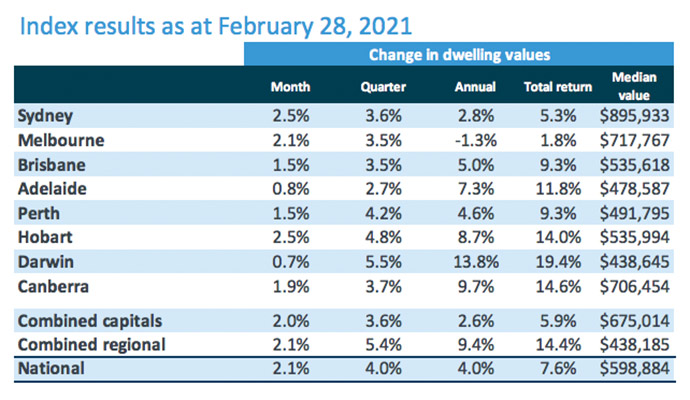Property market goes ‘boom’, prices rise at the fastest pace since 2003

A confluence of post-COVID factors is driving some torrid activity in the housing market. (Pic: Getty)
Australia’s property market is going nuts for the first time in over a decade.
CoreLogic’s latest monthly data release shows house prices rose nationally by 2.1 per cent in February — the biggest monthly change since August 2003.
Here’s what a “broad-based boom” looks like, in table form:

It’s being driven by a confluence of post-COVID factors, most notably rock-bottom interest rates which Lawless highlighted in his January analysis (when prices also hit new record highs).
In his February commentary, Lawless said housing supply remains at “historically low levels”, at the same time as demand drives a surge in transactions.
Anecdotally, he cited a couple of activity indicators that support the supply/demand imbalance, which is now a “central factor pushing prices higher”.
“Vendor discounting rates were estimated at a record low of 2.6 per cent in February,” he said, while auction clearance rates have also been “well above average”.
In addition, things are heating up at the expensive end of town, after pricier houses in Sydney and Melbourne led the property slowdown (from 2017 to 2019) as regulators put the brakes on investor lending.
But Corelogic’s February data showed properties in the “upper quartile” in terms of value are now leading the rebound, Lawless said.
The high-end trend is less pronounced in Perth, where the property market is dancing to the tune of another commodities boom.
Not only are house prices rising across the board out west, rents are surging too (by more than 10 per cent) as interstate migration picks up.
“Overall, Australia’s housing market is now well entrenched in one of the strongest growth phases on record,” Lawless said.
He added you’d have to go back more than a decade to find such consistent growth across every capital city and regional area, when the economy was recovering out of the global financial crisis in 2009.
Such positive growth in the wake of a global pandemic may seem “counter intuitive”, Lawless said.
But along with low rates and tight supply, he also cited the strong rebound in economic growth as Australia tracks for a V-shaped recovery.
Can it keep going? Lawless says yes. The only near-term headwind he flagged is a possible resettling of economic conditions as fiscal support measures such as JobKeeper are wound back.
That will hardly offset the plethora of tailwinds that are now merging into proverbial gale-force conditions (don’t forget consumer confidence is also at 10-year highs).
Taken in aggregate, “housing price momentum looks to be skewed towards the upside”, Lawless said.
UNLOCK INSIGHTS
Discover the untold stories of emerging ASX stocks.
Daily news and expert analysis, it's free to subscribe.
By proceeding, you confirm you understand that we handle personal information in accordance with our Privacy Policy.








